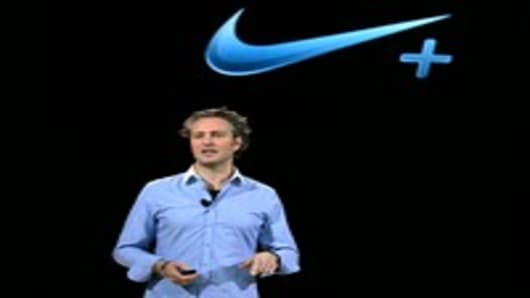When Nike first got into the data-collection game it stuck sensors to elite athletes running, jumping, spinning and generally doing those impossible things they do. The idea was that the data collected would point Nike designers and engineers toward building better shoes.
It did that, but the Nike brain trust understood there was much more the data could unlock, says Stefan Olander, VP Digital Sport at Nike. “We quickly realized that data can be applied much more broadly,” Olander says. “Why wouldn’t we take all this knowledge, all this innovation and give it back to everyone?”
Olander is an odd-bird at Nike. He’s a software guy inside what is effectively a hardware company. Yet his view of the world is gathering massive momentum inside the shoe giant. Let’s say you run in your Nike shoes several times a week, your relationship with the company extends to those things on your feet. You may love your running shoes, but you don’t think about them outside of the run.
Stick a sensor in a shoe, however, as Nike did in partnership with Apple and its Nike+ platform, and all the sudden that activity can show up on your phone, on your laptop, in online conversation with friends and fellow runners.
“When someone comes back to the brands two to three times a week to synch a run, we are suddenly in a completely new era where technology unlocks something completely unprecedented,” Olander says. It’s not just performance, improving on your personal best, but also staying motivated. “When you know so much more about yourself you are able to stay motivated.”
The NikeFuel band is Nike’s biggest effort toward keeping the athlete inside all of us motivated, and it does that through a very simple gathering and presentation of data. Inside the little rubberized wristband, sensors measure the steps you take, the calories you burn and a new universal measure of activity – your “Nike Fuel” points. Nike engineers made a very conscious effort to strip down the device, rather than load it up with features to not distract athletes from whatever activity they are sweating their way through.
We don’t say, go out and run a marathon tomorrow, it’s this incremental change. There is this nudge to keep you going.’
The NikeFuel band is a way for people to set simple, daily goals, Olander says. “You don’t make it this massive change,” Olander says. “You have to think about it as the least amount of uncomfortable change. We don’t say, go out and run a marathon tomorrow, it’s this incremental change. There is this nudge to keep you going.”
Nike Fuel points, which are a measure of oxygen consumption during exercise, are an attempt to create a universal unit to measure activity, any activity. With a common unit a dancer can compare her effort to a shotputter. “You want to have something to compare and compete over, whatever your sport or activity is,” Olander says. And you want to have the recognition or the bragging rights that you earned more NikeFuel points than your buddies. “We are driven by recognition, and once you start getting it, it has an incredible power that is hard to stop.”
Nike is clearly bent on riding that momentum, providing that digital nudge to keep us all active. But Nike doesn’t have all the answers, and all the ways it’s devices can motivate people, Olander says. It plans on opening up the NikeFuel band to outside developers soon. “That is definitely coming in the near future,” Olander says. “The consumer owns the data, there is no reason for us to horde all this.”


